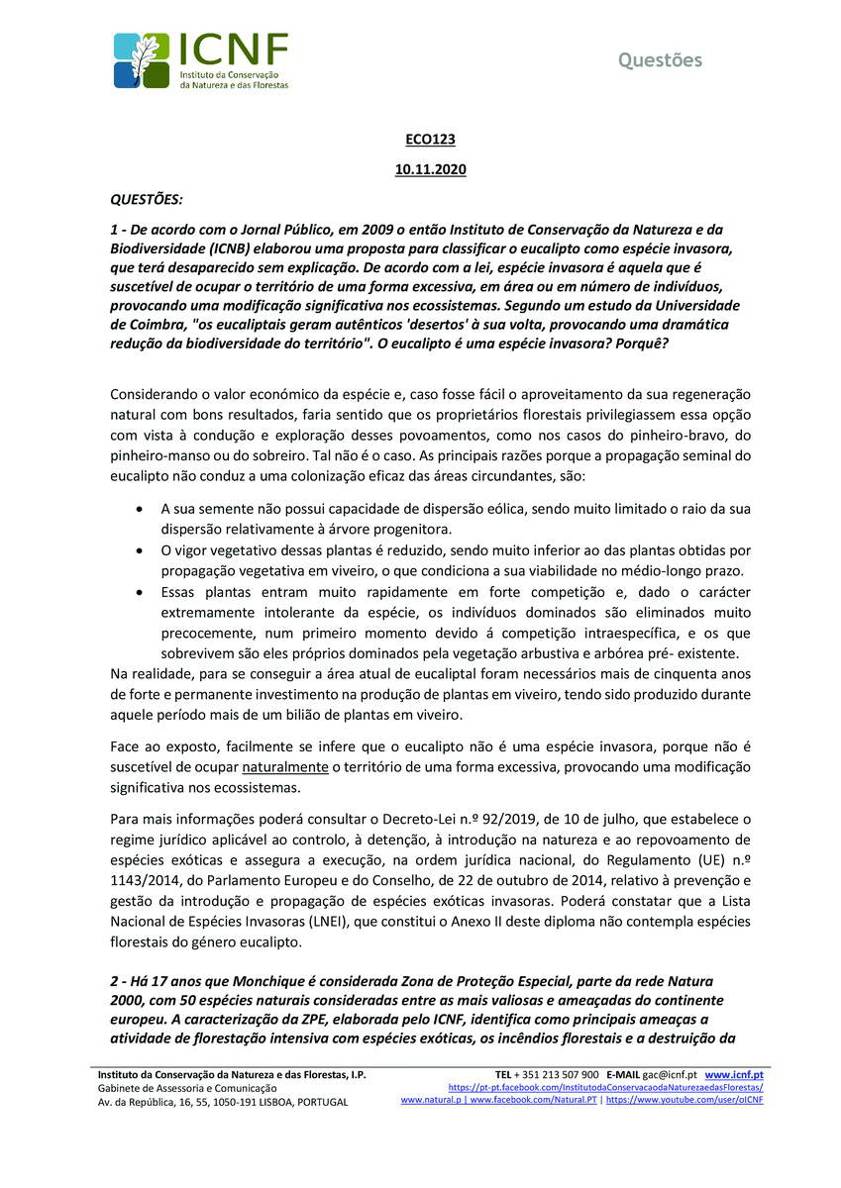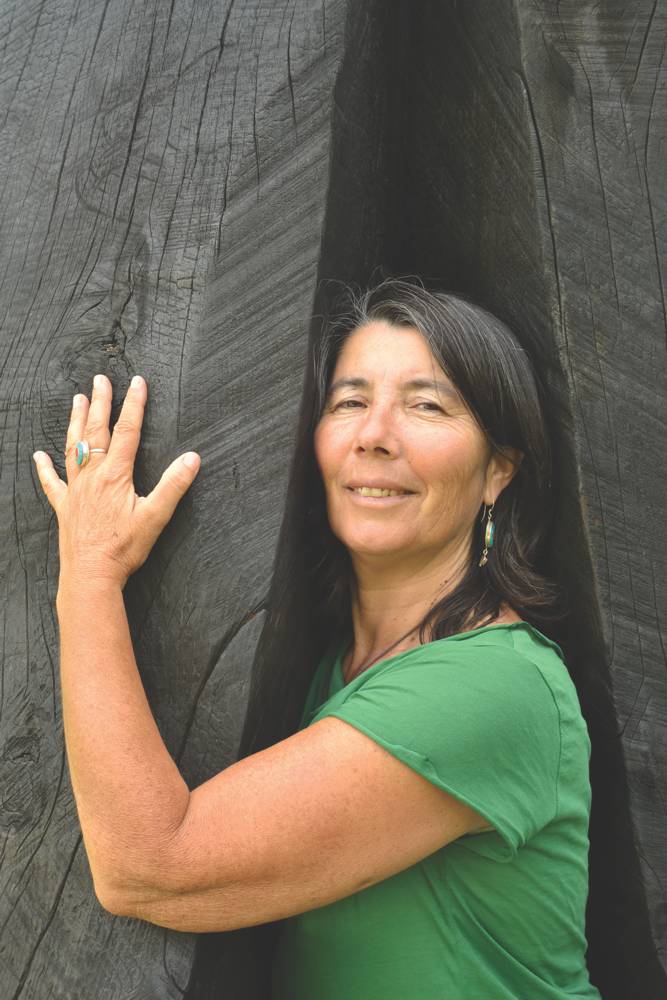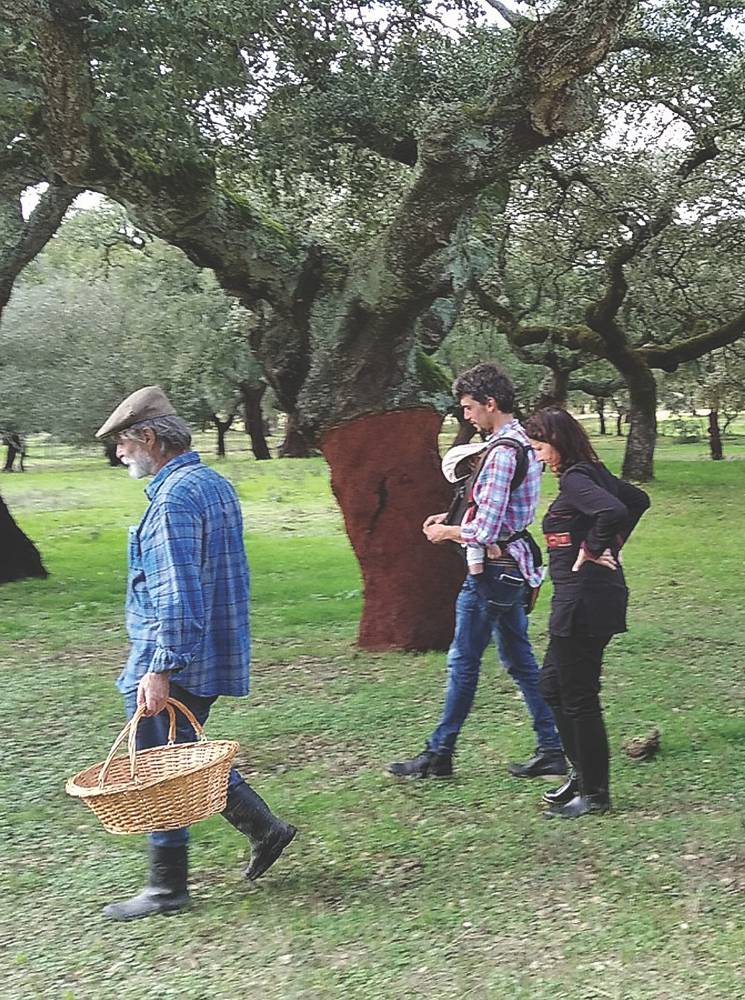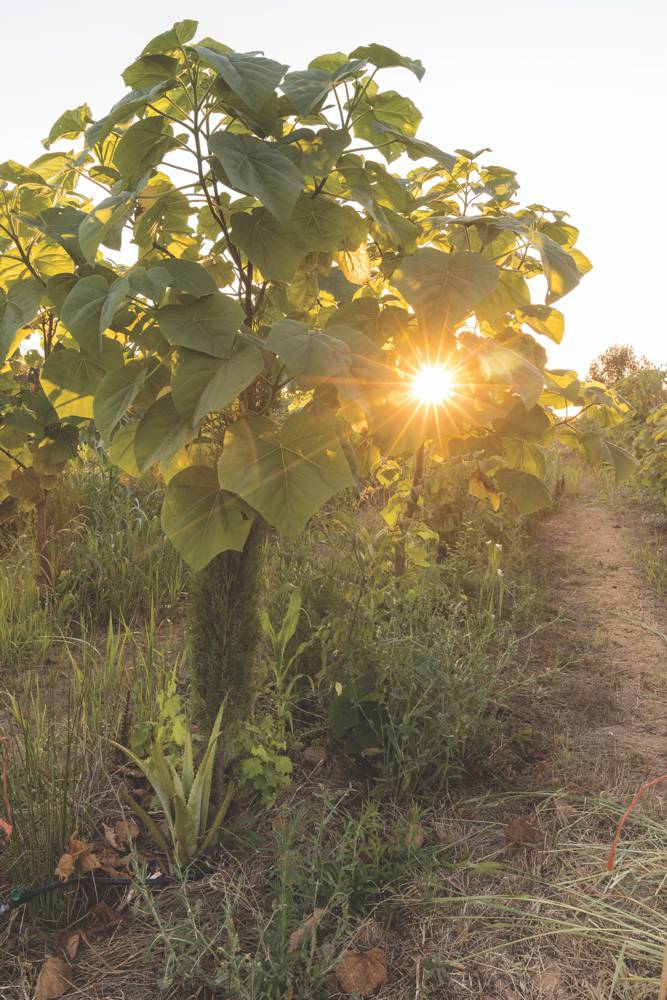Like sap, we rise up through the four layers of a forest. We progress from the bureaucrats in state institutions to experts who are passionate about the forest. Let’s move from the Dantesque vision of the current ‘eucalyptugal’ to the landscape of the lush forest that is to come.
The ground layer
It’s called Quinta da Fonteireira, in Belas, and it is a rare green lung in the suburbs along the Sintra railway line. Between the ages of eight and eighteen, I slept more than a hundred nights there, in Vale Escuro.
At that time, when I was in the scouts, we used the abundant eucalyptus wood to build dining tables, shelters for our equipment, and also to make weapons for games. The tree’s fresh leaves supported the clay with which we built the kitchens, disguised the smell of feet in the tents, decorated the entrances to the camp. Whenever the poles that we had cut for previous camps were not enough, then we would cut away at a new eucalyptus trunk, for, as we had learned, you should only take wood from a trunk from which three more trunks have sprung.
What I didn’t know, like so many children in this country, is that I had fallen for a scam: they had taught me to call an industrial monoculture of eucalyptus trees a forest. And, one day, when the machines came to cut down the trees, 300 at a time, turning everything around our Vale Escuro into a lunar hell, the visceral feeling of injustice rose up in all of us, like sap.
There were two other things that I didn’t know. In the 1970s, that same feeling had already triggered the first environmental struggles in Portugal against the dictatorship of the eucalyptus, and this movement has remained alive until today. And perhaps the future of the forest and of life in our country depends on it.
The herbal layer
There are almost a million hectares. 27% of the so-called “Portuguese forest” is a monoculture of eucalyptus trees, a (dis)proportion that isn’t found to such an extent in any other country in the world.
The figures obtained last June by the newspaper Público, from the ICNF – Institute for the Conservation of Nature and Forests, show that this tree remains by far the most approved species in Portugal. Between October 2013 and June 2020, the planting of more than 80 thousand hectares of eucalyptus was permitted. The second most approved species was the stone pine – with less than six thousand hectares.
After the tragic fires of 2017, the government changed the notorious “Free Eucalyptus Law” of 2013. Today people are only allowed to plant eucalyptus in already existing eucalyptus areas, or in a new area if an equivalent area that is already planted with eucalyptus is uprooted at the same time. But, in the months between the announcement of the law and its coming into force, the greed that always dwells in the shadow of eucalyptus trees reached a new peak. The nurseries, from where more than a billion such trees have come in recent decades, sold out of eucalyptus, in response to the frantic rush for these plants. The figures provided to ECO123 by ICNF reveal the institute’s complicity in this business: approvals were given for the spread of eucalyptus into new areas, reaching a peak in 2017, with more than 2,200 hectares being approved.
In 2018, Monchique fell victim to a brutal fire. Those who live in the mountains, however, watched with disbelief and indignation as scattered eucalyptus trees sprang up after the fire, spreading into new land, and they were also forced to witness the replanting of these dangerous monocultures in the burned areas.
For 17 years, Monchique has been considered a special protection area. Part of the Natura 2000 Network, it is home to 50 of the most valuable and seriously threatened natural species on the European continent. The ICNF had already identified the main threats: intensive forestry work with exotic species; forest fires; and the destruction of the native vegetation.
I had a couple of points I wanted to clarify with this public body. I contacted its headquarters in the concrete forest of Avenida da República, in Lisbon, but they proved to be impenetrable. The ICNF declined my request for an interview, but they did agree to respond by email.
And it was by email that I discovered that the institute has nothing to state with regard to the question of reforestation with eucalyptus. “The National Forest Strategy in Portugal recognises the need to guarantee a response to the demand for raw materials from the main sectors of the forestry industry,” it explains. It states that “reforestation with any forest species doesn’t lead to an increase in its territorial spread, and is fundamental as a measure for containing and minimising the impact on the soil and biodiversity after forest fires.”

“With regard to the supposed behaviour of eucalyptus in forest fire situations,” the ICNF writes, “the analysis of the origin of such situations (…) allows us to single out the effects of human action, due to arson or negligence. (…) We find no reference to situations of ‘high flammability’ relating to any species”.
“It is easy to infer that eucalyptus is not an invasive species,” I read in the email, “because it is not prone to naturally occupying the land in an excessive way and thus causing a significant change in the ecosystems.” The institute further explains: “Its seed has no capacity for dispersal by the wind, and the radius of its dispersal is very limited. The vegetative strength of these plants is much lower than that of plants obtained from a nursery, which conditions their viability. (…) The individual trees are controlled and eliminated early on and those which survive are themselves dominated by the pre-existing shrub and tree layers of the vegetation.”
In other words, there is no relationship between eucalyptus and fires, and eucalyptus does not have an invasive character. This is a view that does not exactly match the one expressed by the local communities, the fire brigade associations or their training academy. Instead, it perfectly matches the view of the paper industry, and companies such as Altri and Navigator.
It nonetheless remains curious that, one year after the 2017 fire, in the midst of the endless ‘assistance’ that was being provided to uproot the ‘carpets of eucalyptus’ springing up everywhere, the community of Benfeita, in the Serra do Açor, banded together to help the ICNF in removing the new eucalyptus trees that were growing inside the woodland of Mata da Margaraça. And, furthermore, in the following year, the Government granted the ICNF 560,000 euros to recover the forest, while an ICNF official also told the Diário de Notícias newspaper about the urgent need to halt “the spread of exotic and invasive species, with special emphasis on eucalyptus and mimosa.”
According to the Público newspaper, in 2009, the then Institute for Nature Conservation and Biodiversity prepared a proposal to classify eucalyptus as an invasive species. This proposal seems to have vanished without any explanation.
This year, researchers from the Technical University of Munich and the University of Zurich used satellite imagery to detect 15 Natura 2000 sites affected by the spread of eucalyptus, nine of which are considered to be “heavily affected”. “These ecosystems are unique and are host to several endangered species,” they reminded Público last August. They considered eucalyptus to be one of the greatest environmental threats, as these trees “replace existing vegetation and serve as fuel for potential forest fires in the future.” A cycle that, in view of the forecast increase in temperatures, is expected to become increasingly recurrent in Portugal.

In 2019, a study by researchers from six institutions of higher education, coordinated by Ernesto de Deus, revealed several examples of the invasive potential of eucalyptus.
In 2018, climate change researchers at the Centre for Applied Ecology of the University of Lisbon, together with other research centres in Coimbra, Porto and Madrid, predicted that, in less than 30 years, the area to the south of the River Tagus would become impracticable even for the cultivation of eucalyptus. They estimate that areas given over to the intensive production of this monoculture will continue to be abandoned, and that the oasis of biodiversity will be under increasing threat, calling for the “creation of new protected areas”.
In 2017, an international study, in which the University of Coimbra participated, concluded: “eucalyptus trees generate real ‘deserts’ around them, causing a dramatic reduction in the biodiversity of the land.”
In a country where 60% of the land is at risk of becoming a desert, what should be done with the whole area of eucalyptus plantations, which the law continues to allow to be cut down and replanted until the soil is sucked completely dry?
The shrub layer
“When the last tree has fallen, when the last river has dried up, when the last fish has been caught, you will understand that you can’t eat money.” This well-known proverb hits me as soon as I open the 2021 “Medicinal Trees” diary by Fernanda Botelho.
As I glance through the days of the year, I discover countless trees, together with their histories and uses. “I find it very puzzling that adults and children don’t know even half a dozen trees by name. We frequently have no relationship with the origins of the product we are eating…,” says the specialist in medicinal plants and a botanical tour guide. “You can get up close to trees, find out what leaves, what fruits they have. Plants and trees are the basis for sustaining life on the planet!”

“There is a brutal imbalance in the management of the forest. It could be done with an eye to the future instead of with an eye to the euros that can be made. The forest is planted as an asset to serve us, to be exploited to exhaustion, to give us money quickly. With the constant planting and replanting of eucalyptus, the soils are exhausted – in complete disregard for the tree itself. A eucalyptus plantation is much closer to a desert than to a forest,” says Fernanda Botelho, “and we are all guilty: we all like paper.” “I’m not against eucalyptus. I am against all types of monoculture. We have to think about the future, about a sustainable form of management where there is room for us all – goats, insects, all of us… to create a balance.”

© Fernanda Botelho
“If we travel from the north to the south of the country, the spread of eucalyptus monocultures is frightening. They are becoming all joined up. Hence, they are now referred to as green deserts,” observes the biologist José Mateus. “It’s cheaper to plant eucalyptus, but, in the end, what appears to be cheap turns out to be expensive.”
“What we have is an excellent plant that is being very poorly managed,” observes the agroforestry expert. “The landscape is being completely destroyed by the cultivation of eucalyptus. It is extremely flammable and it’s always sucking up water and damaging resources. The extraction techniques are brutal: everything is cut away and removed in one go, with no apparent sensitivity being shown about what is happening underneath. The production is designed to be a monoculture which depends on everything that is external, in order to get the whole economy working and to have to buy everything new. The management of these plantations is designed to maximise profit, requiring only a minimum level of intervention, in order to ‘produce money without any trouble’.”
However, this approach contributes to the desertification of the inland regions, leading to a lack of jobs and making it no longer safe to live in the countryside. “It’s reached the point where they want to ban people from living in some places, when it should be the other way around! People should be encouraged to take care of the forest and to have a type of forest that is not transformed into a powder keg.”

© Inês Sambas
For Fernanda Botelho and José Mateus, there is an urgent need to change our production methods. And this applies to the eucalyptus as well as to pears, tomatoes, avocados or olive groves. “With huge war machines, like mechanical diggers, tractors and agricultural implements, we have immense destructive power: we can get back to square one in one day. As soon as they stop moving, there will be a constant evolution of the system, beautiful pre-forest woods, a sequence of plants appearing one after the other and the vegetation growing towards becoming a forest.”
“The trees are wonderful, but the ones that appeal to me most are the little herbs that nobody sees, that live on the forest floor and on the trunks of trees. Without them, the other species can’t live! They attract ladybirds and butterflies, provide food for the birds, and they are also our great allies as edible and medicinal wild herbs. From the top of the trees to the ground beneath, and even to what lies below that, everything is connected. You shouldn’t look at the forest without seeing all the threads that are part of this immense web,” Fernanda tells me, before continuing to work on her garden in the Sintra area. “I respect eucalyptus a lot, particularly for all its medicinal properties, which allow us to treat problems of the respiratory tract. The management of this tree’s cultivation could be carried out in another way, nourishing the soil with a lot of soil cover, planting the tree in more controlled and much smaller groups. The forest gives us everything we need, everything, everything.”
The tree layer
“It won’t work!” José Mateus, frequently used to hear this comment, due to the fact that his experiments with the land are somewhat unconventional. We were in Grândola, and the biologist was growing a vegetable garden, which he had covered with wood chips, without any manure. Today the garden is leafy and abundant and he hopes the whole agroforestry project that he is designing and implementing on a hillside of the chef Ljubomir Stanisic’s farm in the Alentejo will also turn out like this. In a country where 98% of the forest is privately owned, José likes to work directly with landowners, so that he can cover a larger area, making it easier for him to implement his work. “With funded projects, this complexity makes things difficult. The projects are supposed to be simple. You can’t mix a forest project with an aromatics project, a fruit tree project, or a vegetable project…”.
Ever since he was a child, he has been fascinated by all living things. With his grandfather, the first plant he learned the name of was the rock rose. “Today, it’s a plant that I work with a lot, and which is hated by many people who think that it turns the land into a desert. It’s particularly interesting because it’s one of the first plants to be used in the production of large-scale flax biomass. We cut it, put it in place and crush it if there’s a lot of it, so that we can improve the condition of the soil. I have done this job of trying to dissociate the good from the bad, working on the dual qualities of plants. Each plant has its place.”

The same applies to the eucalyptus. “It’s an incredible plant and can be a great tool. It’s a champion of photosynthesis, very efficient at fixing carbon dioxide and producing cellulose. We could use eucalyptus to create a forest. If it is felled and removed carefully, you could produce this wood and still enjoy the things that are already there after 5 to 10 years, things that grow in the shade. It could be planted at intervals, together with acorns.”
“We have to start cultivating several different things at the same time in the same place. We can use the tools of horticulture, forestry, fruit production, even animal production, in the same space. Bring all the disciplines together.” For this agroforestry enthusiast, in the near future we will have to go through a process of gradually converting eucalyptus. Instead of using machines to pull out the roots and undoing everything in order to plant eucalyptus again, “we can use this money to plant and manage the tree more carefully: we can use young leaves for essences, use the wood, branches and what is left of the eucalyptus regrowth, this biomass, to lead the forest from below.” It’s not a question of eradicating eucalyptus, but of realising and harnessing its true potential: a “pioneer plant, like broom, which appears at the beginning of a forest’s replenishment and then stops having its place. We should take the opportunity to cut it down, with pruning, with careful management, so that it can support the growth of the more demanding plants. So that a young oak or cork-oak can grow underneath and we can make the transition to more diverse forests, from which you can get more products, be they aromatics, wild fruits of the forest, hardwoods, nuts, dried fruits…”
“How much work would a multifunctional forest provide, given the number of people who have to take care of it?” asks José Mateus. “How much would such a transformed landscape be worth? What value would it have in terms of water retention in the landscape, fire prevention, the production of our food, the creation of soil? What wild fauna would return?”
“I see forests being developed on a small scale,” ventures Fernanda. “Before introducing plants from Australia, we should take advantage of our Mediterranean flora, which is so, so rich. Blueberries, apples, walnuts, hawthorn, carob, pomegranates, elderberries … They have so much potential! At the moment, people only make brandy with the medronho, but we can also use it for jams and many other purposes. You can do even more with acorns. It varies from one area to another. We can mix many more trees and species together, like the vine and the olive-tree, which can live quite happily alongside one another. We can sell these plants as medicinal herbs, dry them, sell them as teas, for the benefit of the community, disseminating and recovering our ancestors’ knowledge, which is currently dying out. We have to come up with economically viable proposals and also make it clear that money is not everything.”
“We are lucky to have really diverse forests, many microclimates, an incredible diversity of species. I see forests producing a lot of things,” agrees José Mateus. “We must always ask: what is the potential of the forest in this region? In every part of the country, we have great potential for developing forests. They grow at different speeds, with different species, but the overall result will be a lush, biodiverse and incredible forest.”

In each region, one type of oak will predominate. This will form the basis of the forest, providing more connections to all the other elements and giving more stability to the system, and it will have potential companions. “For the south of the country, we must have more cork or holm-oaks, with almonds and peaches; for the coastal region in the centre of the country, we must have more common oaks, together with walnut trees, which do well in limestone areas; for the regions inland, we can have more black oaks, together with cherries; further to the north, white oaks, together with chestnuts. All of this without irrigation. And we can have a series of products: aromatic herbs, winter garden crops between the rows of trees in the forest… If we want to see things on a larger scale, we can go to the forest for wood, mushrooms, game, tourism…”
For this agroforestry trainer, two measures would make a big difference towards the restoration of the forest. On the one hand, we must create a more selective method of scrub clearance, one that supports the natural succession of plants. “You will be eliminating the more thorny and aromatic phases of the forest’s regrowth – the cistus, gorse and broom, which burn easily. And you can leave in place fruit trees, arbutus shrubs and hawthorn bushes, which are less fire-friendly and more fauna-friendly: supporting all the small birds and animals that will keep the system in balance, and protecting it against pests.” On the other hand, there must be special protection for several important shrubs and trees, just as there is today for the cork-oak.
“In nature, everyone should be constantly working towards increasing the complexity of the system. Life always creates the conditions that are needed to sustain more life. Humans are the only living beings that don’t do this. They’re always trying to simplify things and go back to the savannah. We have cleared away so much with this vision of wanting everything clean and simple that we’ve lost those elements that bring stability to the system. I think it’s essential that we should know the natural laws and processes, understand them and replicate them.”

The examples of Ernst Götsch (the father of syntropic agriculture) and the Herdade do Freixo do Meio, in Montemor-o-Novo, are an inspiration for José and Fernanda.
“When I was a child, I remember saying, ‘it takes 50 years to grow!’ People are discouraged from planting trees, because it will take time. A well-maintained oak, cork or pine-tree will grow much faster than we generally imagine. If I had planted a forest when I was ten, I would now be looking at a large forest, 25 years later!
 Eco123 Revista da Economia e Ecologia
Eco123 Revista da Economia e Ecologia


